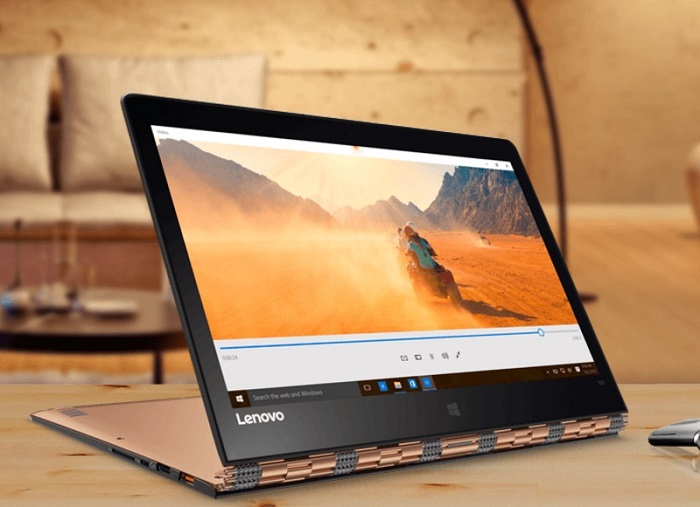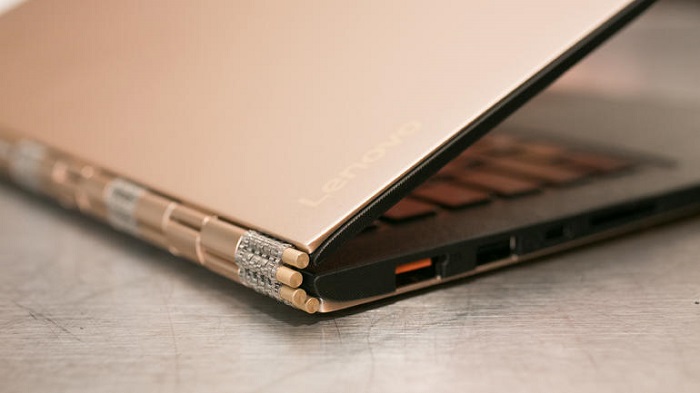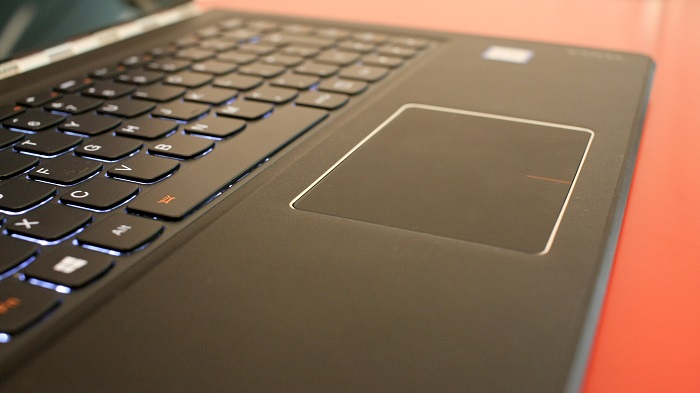Lenovo seems to have heard the criticisms made, and those that made the users-because the new Lenovo Yoga 900 corrects almost all the flaws of its predecessor and delivers a portable 2 in 1 convertible inheriting the best of Yoga and range and racing is an increasingly bitter struggle in this segment.
A design that highlights the hinge
Let’s start with the bad news. The Yoga 900 is heavier and thicker than its predecessor. It is, however, for very good reasons. Yoga Pro 3 is focused on thinness and weight as fundamental factors, but that was we met a team with a battery below the average and power also room for improvement.
These two factors have been fixed in the new Yoga 900, but this Lenovo engineers have not hesitated to slightly increase both the weight of the device which rises to 1.30 kg from 1.19 anterior- and thickness, reduced from 12.8 mm from Yoga Pro 3 to about 16 mm of this new model.
That makes the team is not exactly a “pen”, but still we have a good bet and a great balance of size, weight and performance. 900 Yoga design is similar to the previous model, with a magnesium alloy as the lead in the upper housing in which, yes, the brand “Yoga” appears more prominent than “Lenovo”. JBL speakers on either side of the team, as we saw offer excellent sound quality even when we put the notebook in tablet mode: a curious detail appears at the bottom.

That is precisely one of the salient features of the Yoga range, and those four operating modes (laptop, shop, kiosk and tablet) than previous models boasted repeatedly occur in this case. The hinge design that curious again to be star of this design, but also of being in form so is his behavior, since their behavior is exemplary.
The design on the inside does not disappoint, although it is true that the frames surrounding the 13.3-inch screen are perhaps somewhat exaggerated. The backlit keyboard and touchpad (with dimensions of 90 x 60 mm) are surrounded by a plastic material that mimics the leather finish with a really nice result and much warmer than other materials that we tend to “receive” when we started use the keyboard and touchpad.
The sides are well used to the connection ports, including both USB 2.0 port, which highlights is also used as a charger port and the USB-C port that allows us to use it to connect your computer, among other things, external monitors. Too bad there are no physical volume controls, something that would be appreciated especially when using the computer in tablet mode.
USB-C port that supplants the use of other traditional ports such equipment to connect to external monitors and is one of the bets that will be consolidated throughout the year. The versatility and convenience provided by this type of connector is makes an excellent choice, but yes, it will force us to ask with a suitable adapter to take advantage of the Display Port or HDMI connection of these screens.
Here in TheKindle3Books we recommend you to read also: Windows 10: Microsoft reveals in detail the minimum requirements
Specifications and performance Lenovo Yoga 900
The changes to the exterior are not noticed as much as those seen inside this equipment. Lenovo has decided to dispense with the Core M processors on this machine to bet on more ambitious micros U series Skylake family , which among other things requires using an active ventilation guarantees -the Yoga Pro 3 included a small fan M- Core despite what we must also add the presence of a significantly higher capacity battery.
| Lenovo Yoga 900 | |
| Screen | IPS 13.3-inch multi-touch 10 points |
| Resolution | 3,200 x 1,800 pixels |
| Processor | Intel 2.5 GHz Core i7-6500U |
| Graphics | Intel HD Graphics 520 |
| RAM | 16 GB RAM |
| SSD | 512 GB |
| OS Version | Windows 10 |
| Connectivity | Dual Band WiFi 802.11 ac / Bluetooth 4.0 / HDMI / JBL SD / 2 x USB 3.0 / 1 x USB 2.0 (charging) / 1 x USB-C |
| Dimensions | 299.72 x 208.28 x 15.49 mm |
| Weight | 1.3 kg |
| Battery | 66 Wh |
In these specifications are other featured topics such as the use of a multitouch IPS display with 1440p resolution that re-emphasizes its fantastic quality and definition, something to which we are accustomed Lenovo computers. Outdoor screen that suffers in its brightness and contrast, but it is difficult for a non-matte screen does not.

It is also very important improvement in battery capacity passing the previous model 44.8 Wh to 66 Wh of the current. It shows as we said in the thickness of the team, but that little disadvantage is offset with a range that really meets finally allows this equipment and ensure long work sessions without problems.
Skylake using the new Intel Core i7-6500U processor represents a considerable leap to Intel Core M-5Y70 the previous model, but that is not noticed overwhelming in some synthetic benchmarks that try to analyze the performance of the processing “raw” This model. Where did these differences is especially in graphics performance tests are noted, where the GPU integrated (Intel HD Graphics 520) itself offers a clearly superior performance.
| Yoga Pro 3 (Core M-5Y70) | Alienware 14 (Core i7-4700MQ) | Dell XPS 13 (Core i5-5200U) | Yoga 900 (Core i7-6500U) | |
| PCmark Home | 2,261 | 3,200 | 2,216 | 2,841 |
| Creative PCmark | 2,844 | 3,576 | 3,280 | 3,722 |
| 3DMark Cloud Gate | 3,076 | 6,262 | 5,180 | 5,472 |
| 3DMark Ice Storm | 26,361 | 18.026 | 50,172 | 60,246 |
This new processor requires a more powerful cooling solution, of course, and here Lenovo did not want to have problems and go two 35 mm fans and ventilation outlets are well hidden just below the hinge. This solution ensures that the processor will maintain proper temperatures, although it may sometimes much effort we display the traditional “snort” indicating that these fans are working at maximum, but even then the noise generated is more than acceptable.
The battery does not disappoint
All these specifications may not be noticed much in these synthetic benchmarks, but certainly where it is noticeable in daily work with a team that is certainly more than enough for most typical applications. 900 Yoga is based on Windows 10, and the operating system behaved perfectly especially in harnessing this chameleon-like ability to use this equipment in various ways.
The native resolution is too high for virtually any user, which means that in most cases is much more advisable to use the scaling of visual elements and fonts on screen. We we place 125% and able to work optimally, but it is clear that this is the end user who decides to feel as comfortable as possible.
As mentioned above, the battery wins many integers thanks to this increased capacity, and a regular use of the equipment with the average brightness and a fairly intensive use of the browser, a music player, WiFi enabled and the occasional video playback laptop He exceeded 8 hours of autonomy. A figure that cannot be so high with other teams -here the 1440p display is a handicap- but I certainly can leave much quieter than previous models.
Here in TheKindle3Books we recommend you to read also: ZGPAX S28, the economic Smartwatch
Keyboard and mouse: room for improvement
We complained in the analysis of Yoga Pro 3 last Lenovo’s decision to remove the top row of function keys year, Lenovo seems to have decided here listen to criticism because now we have that row of function keys which also There are shortcuts for access to multimedia content and some other curious. For example, F4 found a blade that allows us to close the active window whether you use the Alt + F4 and only if you press this key combination.

That provision is a catch: the presence again of the special column of keys to the right. in which we find for example the access to the Home or End key This provision favors some sections-the cursor keys have the size but adequate- undermines the position of the Delete key, of course, the enter key.
During the drafting of texts often we were wrong to try to delete something and finish by pressing the Home key while instead of the Enter key pulsation “C” or keys “End” and “PageUp” interchangeably when dealing the “right” place meets with the position.
Get used to this provision is a matter of time, of course, but first that placement is not as natural as other keyboards but favors the overall size of some keys. In our sessions I managed to be around 80 words per minute on the keyboard while in other keyboards to which I’m used to (the Dell XPS 13 or Logitech K800) can reach 95-100 words per minute.
Lenovo Yoga touchpad 900 is suitable in size (90 x 60 mm) but a slightly larger touchpad would have been appreciated. Yet their behavior with Windows 10 was perfect in our tests, with good response times, good scroll in applications such as Microsoft Edge and traditional gesture support.

